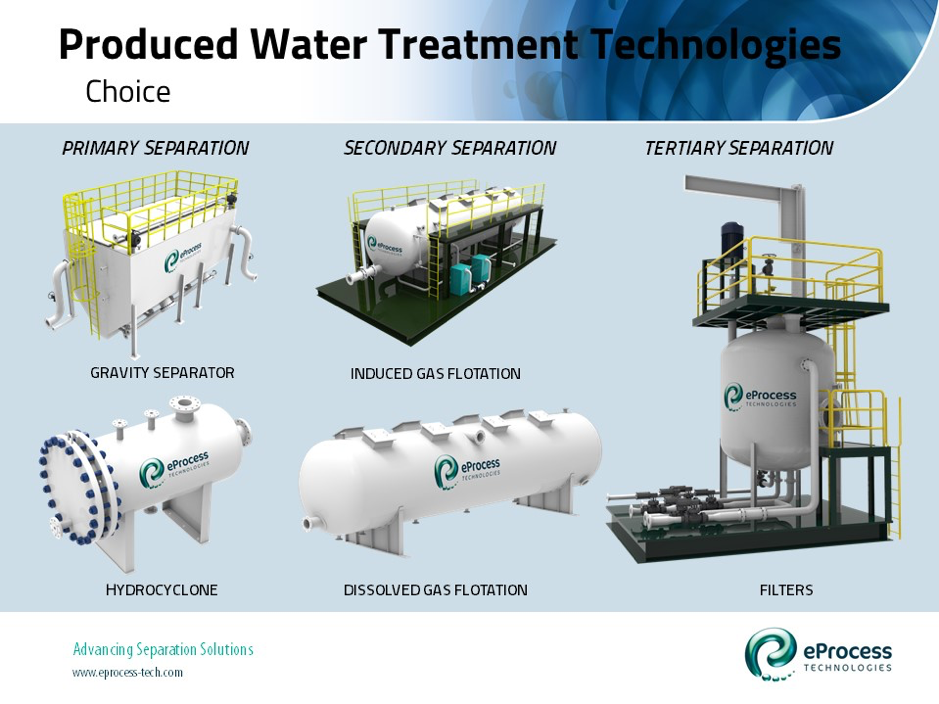Produced Water Treatment with Deoiling Hydrocyclones - Misconceptions & Corrections (B-PWT003)
Produced Water Treatment Technology; Choice
Here we present a very basic overview of applicable produced water treatment technologies, and provide a description of operational mechanisms.
This overview addresses only proven commercially available technologies, and those with a long commercial track record. Furthermore these technologies only addresses the treatment of free oil from the water dispersions, and not the dissolved fraction.
As we addressed in earlier discussions, free oil in water dispersions are categorised as either primary dispersions or secondary dispersions.
Primary dispersions are those where it’s sufficient to utilise simple gravity type equipment to undertake the separation, whereas secondary dispersions will require enhanced gravity or additional separation forces to facilitate adequate separation.

PRIMARY SEPARATION
Gravity Separators
Gravity separators are called many names including skim tanks, skim vessels, water clarifiers or API separators. They are the simplest and most widely used devices for removing dispersed oil from water.
They can be either vertical or horizontal, and are either pressure vessels or atmospheric tanks, which provide sufficient retention time, so that the free oil will have time to rise to the surface of the tank, where it’s skimmed off and collected. There are many different designs ranging from field modified storage tanks to purpose built vessels incorporating special inlet and outlet devices.
Design options include:
- Vertical Down Flow Tanks
- Horizontal Skim Tanks
- Vortex Tanks
Integrated into some gravity separators are coalescing devices, which provide a solid surface, which can be contacted by small oil droplets. The droplets collect on the surface and coalesce into a continuous oil film. As the film becomes thicker, large drops of oil break loose due to gravity, and rise to the water surface for collection and removal.
These coalescing devices include:
- Parallel Plate Separator or Corrugated Plate Interceptor
- Granular Media Coalescers
- Coalescing Filter Cartridges
Gravity separators are used primarily to separate the majority of the free oil (or easy dispersion) from the water and are often used upstream from other oil in water removal equipment.
Hydrocyclones
More on these later.
SECONDARY SEPARATION
Gas Flotation
Gas Flotation is a process whereby fine gas bubbles are formed in the water and attach themselves to particles of oil or solids, which help to lift them to the water surface for collection. Chemicals such as coagulants, polyelectrolytes or demulsifiers may be added to improve performance.
The main design features of a gas flotation unit are:
- Introduction of finely dispersed gas bubbles into the water stream to be treated, utilising the full vessel volume.
- A zone of minimum turbulence, with no short-circuiting between inlet and outlet water flows
- Removing the separated oil from the water surface, after an adequate retention time
Gas Flotation units are defined as either:
Dissolved Gas Flotation (DGF); typically in elevated pressure systems where the gas is dissolved in the produced water. When the pressure is released in the floatation vessel the gas bubbles evolve naturally out of solution.
Induced Gas Flotation (IGF); in low pressure systems the gas is introduced into the water either by a mechanical rotor or an eductor device. Most IGF vessels contain a number of separate cells (typically up to four) where the water is progressively cleaned.
Gas Flotation units typically operate at lower pressure, downstream of Gravity Separators and Hydrocyclone units.
There is some debate about the relative merits of horizontal vs. vertical vessel orientation and performance. Although the advantage of a vertical orientation on smaller footprint size is obvious, no real reason for an advantage either way is observed in performance.
TERTIARY SEPARATION
Filters
Filter equipment is normally utilized for fine solids removal where this is a problem, however various filter systems are also used for the removal of oil in water, where low concentrations of oil are present, and further polishing of a very difficult application is required. In most instances these filters operate in two stages including filtration, where the suspended oil and solids are removed from the water stream, and backwashing, where the suspended oil and solids are removed from the filter system.
We provide only some filters types here including:
Sand Filters; where the filter media is sand, or anthracite coal or carbon
Multimedia Filters; where the media filter is made up of two types of media, anthracite coal and garnet.
Nut-Shell Filters; as the name suggests the media filter is either a mixture of ground pecan or walnut shells or both.
Cartridge Filters; are available in a wide variety of materials and pore sizes, as both disposable and back-washable types. Materials of construction include, pleated paper, polypropylene, glass fibre, sintered metals, woven metal screen mesh, woven wool or cellulose fibres, and epoxy bound sand.
